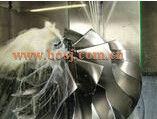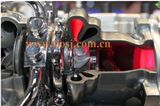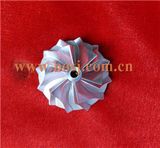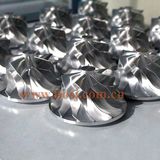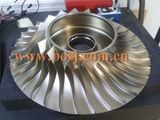| Prod Model: |
BOSJ-T |
| Markets: |
North America,South America,Eastern Europe,Southeast Asia,Africa,Oceania,Mid East,Eastern Asia,Western Europe |
| Making Machine: |
5 Axis |
| Type: |
Compound Turbo System |
| Body Material: |
Aluminium |
| Certification: |
RoHS |
Product Description
Turbine
Energy provided for the turbine work is converted from the enthalpy and kinetic energy of the gas. The turbine housings direct the gas flow through the turbine as it spins at up to 250,000 rpm. The
size and shape can dictate some performance characteristics of the overall turbocharger. Often the same basic turbocharger assembly is available from the manufacturer with multiple housing choices
for the turbine, and sometimes the compressor cover as well. This lets the balance between performance, response, and efficiency be tailored to the application.
The turbine and impeller wheel sizes also dictate the amount of air or exhaust that can be flowed through the system, and the relative efficiency at which they operate. In general, the larger the
turbine wheel and compressor wheel the larger the flow capacity. Measurements and shapes can vary, as well as curvature and number of blades on the wheels.
| Application | Replace wheel number: ???
Fit CHRA : 700177-0001
Fit Turbo # : 714569-0001, 714569-0002, 714569-0003 |
| Product Situation | Brand New
Maximum boost 5 bar / 70 Psi |
| Balance | Balanced By SCHENCK Germany
Ready to competition |
| Wheel Size | Inducer Dia.: 54.97 / 76.13 mm (Trim 52)
Exducer Dia. : 76.13 mm
Extend Tapered Tip Exducer dia : 82.54 mm
Tip Height: 6.55 mm
Super Back Height: 2.36 mm
Bore: 5.99 mm
Blade : 6+6 |
| Material | Forged Aluminum |
| Note | We can customize billet compressor wheel, Please contact us if you need it.
We can combine shipping for all items and will send invoice when we receive all of your order. |
On the left, the brass oil drain connection. On the right are the braided oil supply line and water coolant line connections.
Compressor impeller side with the cover removed.
Turbine side housing removed.
A turbocharger's performance is closely tied to its size. Large turbochargers take more heat and pressure to spin the turbine, creating lag at low speed. Small turbochargers spin quickly, but may
not have the same performance at high acceleration. To efficiently combine the benefits of large and small wheels, advanced schemes are used such as twin-turbochargers, twin-scroll turbochargers,
or variable-geometry turbochargers.
Twin-turbo
Twin-turbo or bi-turbo designs have two separate turbochargers operating in either a sequence or in parallel. In a parallel configuration, both turbochargers are fed one-half of the engine's
exhaust. In a sequential setup one turbocharger runs at low speeds and the second turns on at a predetermined engine speed or load. Sequential turbochargers further reduce turbo lag, but require an
intricate set of pipes to properly feed both turbochargers.
Two-stage variable twin-turbos employ a small turbocharger at low speeds and a large one at higher speeds. They are connected in a series so that boost pressure from one turbocharger is multiplied
by another, hence the name "2-stage." The distribution of exhaust gas is continuously variable, so the transition from using the small turbocharger to the large one can be done incrementally. Twin
turbochargers are primarily used in Diesel engines. For example, in Opel bi-turbo Diesel, only the smaller turbocharger works at low speed, providing high torque at 1,500-1,700 rpm. Both
turbochargers operate together in mid range, with the larger one pre-compressing the air, which the smaller one further compresses. A bypass valve regulates the exhaust flow to each turbocharger.
At higher speed (2,500 to 3,000 RPM) only the larger turbocharger runs.
Smaller turbochargers have less turbo lag than larger ones, so often two small turbochargers are used instead of one large one. This configuration is popular in engines over 2,500 CCs and in V-
shape or boxer engines.
Twin-scroll
Twin-scroll or divided turbochargers have two exhaust gas inlets and two nozzles, a smaller sharper angled one for quick response and a larger less angled one for peak performance.
With high-performance camshaft timing, exhaust valves in different cylinders can be open at the same time, overlapping at the end of the power stroke in one cylinder and the end of exhaust stroke
in another. In twin-scroll designs, the exhaust manifold physically separates the channels for cylinders that can interfere with each other, so that the pulsating exhaust gasses flow through
separate spirals (scrolls). With common firing order 1-3-4-2, two scrolls of unequal length pair cylinders 1-4 and 3-2. This lets the engine efficiently use exhaust scavenging techniques, which
decreases exhaust gas temperatures and NOx emissions, improves turbine efficiency, and reduces turbo lag evident at low engine speeds.
Variable-geometry
Variable-geometry or variable-nozzle turbochargers use moveable vanes to adjust the air-flow to the turbine, imitating a turbocharger of the optimal size throughout the power curve. The vanes are
placed just in front of the turbine like a set of slightly overlapping walls. Their angle is adjusted by an actuator to block or increase air flow to the turbine. This variability maintains a
comparable exhaust velocity and back pressure throughout the engine's rev range. The result is that the turbocharger improves fuel efficiency without a noticeable level of turbocharger lag.
Compressor
The compressor increases the mass of intake air entering the combustion chamber. The compressor is made up of an impeller, a diffuser and a volute housing.
Main article: Centrifugal compressor
The operating range of a compressor is described by the "compressor map".
Main article: Compressor map
Additional technologies commonly used in turbocharger installations
Intercooling[edit]
Illustration of inter-cooler location.
When the pressure of the engine's intake air is increased, its temperature also increases. In addition, heat soak from the hot exhaust gases spinning the turbine may also heat the intake air. The warmer the intake air, the less dense, and the less oxygen available for the combustion event, which reduces volumetric efficiency. Not only does excessive intake-air temperature reduce efficiency, it also leads to engine knock, or detonation, which is destructive to engines.
Turbocharger units often make use of an intercooler (also known as a charge air cooler), to cool down the intake air. Intercoolers are often[when?] tested for leaks during routine servicing, particularly in trucks where a leaking intercooler can result in a 20% reduction in fuel economy.[citation needed]
(Note that intercooler is the proper term for the air cooler between successive stages of boost, whereas charge air cooler is the proper term for the air cooler between the boost stage(s) and the appliance that consumes the boosted air.)
Water injection
An alternative to intercooling is injecting water into the intake air to reduce the temperature. This method has been used in automotive and aircraft applications.
Fuel-air mixture ratio
In addition to the use of intercoolers, it is common practice to add extra fuel to the intake air (known as "running an engine rich") for the sole purpose of cooling. The amount of extra fuel varies, but typically reduces the air-fuel ratio to between 11 and 13, instead of the stoichiometric 14.7 (in petrol engines). The extra fuel is not burned (as there is insufficient oxygen to complete the chemical reaction), instead it undergoes a phase change from atomized (liquid) to gas. This phase change absorbs heat, and the added mass of the extra fuel reduces the average thermal energy of the charge and exhaust gas. Even when a catalytic converter is used, the practice of running an engine rich increases exhaust emissions
Wastegate
Many turbochargers use a basic wastegate, which allows smaller turbochargers to reduce turbocharger lag. A wastegate regulates the exhaust gas flow that enters the exhaust-side driving turbine and therefore the air intake into the manifold and the degree of boosting. It can be controlled by a boost pressure assisted, generally vacuum hose attachment point diaphragm (for vacuum and positive pressure to return commonly oil contaminated waste to the emissions system) to force the spring loaded diaphragm to stay closed until the overboost point is sensed by the ecu or a solenoid operated by the engine's electronic control unit or a boost controller, but most production vehicles use a single vacuum hose attachment point spring loaded diaphragm that can alone be pushed open, thus limiting overboost ability due to exhaust gas pressure forcing open the wastegate.
Anti-surge/dump/blow off valves
Turbocharged engines operating at wide open throttle and high rpm require a large volume of air to flow between the turbocharger and the inlet of the engine. When the throttle is closed, compressed air flows to the throttle valve without an exit (i.e., the air has nowhere to go).
In this situation, the surge can raise the pressure of the air to a level that can cause damage. This is because if the pressure rises high enough, a compressor stall occurs-stored pressurized air decompresses backward across the impeller and out the inlet. The reverse flow back across the turbocharger makes the turbine shaft reduce in speed more quickly than it would naturally, possibly damaging the turbocharger.
To prevent this from happening, a valve is fitted between the turbocharger and inlet, which vents off the excess air pressure. These are known as an anti-surge, diverter, bypass, turbo-relief valve, blow-off valve (BOV), or dump valve. It is a pressure relief valve, and is normally operated by the vacuum in the intake manifold.
The primary use of this valve is to maintain the spinning of the turbocharger at a high speed. The air is usually recycled back into the turbocharger inlet (diverter or bypass valves), but can also be vented to the atmosphere (blow off valve). Recycling back into the turbocharger inlet is required on an engine that uses a mass-airflow fuel injection system, because dumping the excessive air overboard downstream of the mass airflow sensor causes an excessively rich fuel mixture-because the mass-airflow sensor has already accounted for the extra air that is no longer being used. Valves that recycle the air also shorten the time needed to re-spool the turbocharger after sudden engine deceleration, since load on the turbocharger when the valve is active is much lower than if the air charge vents to atmosphere.
Jiangyin BOSJ S & T Co., Ltd(BOSJ)is a professional manufacturer of roll forming machines.
-------Cable tray roll forming machine
-------Floor panel roll forming machine
-------C channel roll forming machine
-------C&Z shape purlin interexchangeable roll forming machine
-------C shape purlin roll forming machine
-------Z shape purlin roll forming machine
-------Electric cabinet frame roll forming machine
-------Storage rack roll forming machine
-------Highway guardrail roll forming machine
------Steel silo forming machine
------CNC plasma cutting machine
------Steel Coil double-Covering Line
As a leading producer of many types of roll forming machines in China, BOSJ has won worldwide reputation in this field. Our products have broad markets in Southeast Asia, India, North and South America, Western Asia, Russia and Australia. We guarantee first-rate after-sale service and product quality. Establishing abiding friendship with any customers interested in roll forming machines is our goal. Sincerely, we invite you to pay a visit to our company.
BOSJ provides technical service and supports covering the whole process of purchasing and of our machinery products to assure you satisfactory machinery, timely resolutions or problem Service and technology of BOSJ.
We have had great testimonials from our customers all over the world. "Continously improving our product & service quality" is our mission to bring success to us and our customer



